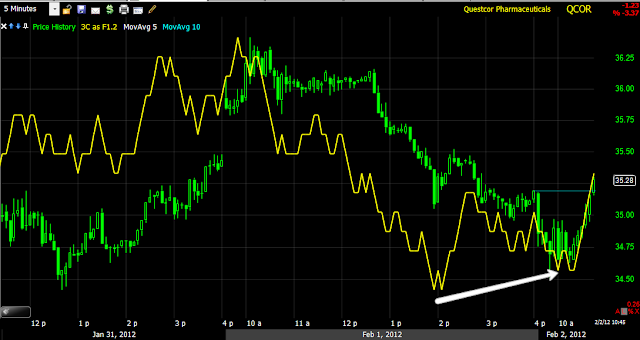AAPL as most of us know, posted what can only be called a “BLOW OUT Quarter” when they reported on January 24th after market. The respectable gap up of 6.24% the next day was entirely due to after hours and pre-market trading, by the way, AAPL had hit an after hours high of about 14% so a few people got left holding the bag on the open the next day. Since we know that institutional money doesn't chase and they certainly don't chase in the thinner extended hours trading, the gap up came from essentially dumb money.
What happens next as far as AAPL adding to those gains,, would be a matter for smart money, retail traders alone don't have the firepower to support a rally in AAPL, as devout as AAPL longs are. In the days since earnings, AAPL's lack of follow through has been noticeable, they've had a gain of 1.88% over the last 7 days and volume as of today has fallen of 81% since the gap up. That's huge volume on the gap up day, but it didn't drive AAPL higher off the open, AAPL actually lost nearly 2% from the intraday highs, which would suggest there was a fair amount of churning going on (strong hands selling to weak hands).
The trade since these blowout earnings has been a point of interest for me. Blowout earnings, a big gap yet no follow though.
We all know earnings can be strange, a company can beat and get sold off or they can miss and rally, a lot of it has to do with guidance for the next quarter. Wall Street looks at earnings in this light, “Earnings we're great, but can thy do better next quarter or have they peaked?”; it's called sentiment.
So in light of the trade in AAPL and because AAPL is arguably the most important stock in the market, with the largest weighting on the NASDAQ 100. If you want to know the true weight from the NASDAQ, you can pay $10k for their weighting schedule. However through a lot of number crunching, we know that AAPL had a weight of 18.4% in 2010, the next stock was MSFT with a weight of 4.5%. At the time, AAPL's weight on the NDX-100 was about the same as the bottom 50 weighted stocks combined, so if you want to move the NASDAQ, you move AAPL, which also means AAPL is a bellwether stock.
So I did a little digging around as to what was behind AAPL's blow out quarter that came on the heels of a very rare AAPL miss the previous quarter. Here's what I found...
As many of you know, AAPL introduced the I-phone with a 5-year exclusive rights contract with AT&T, that meant if you wanted an I-Phone, you had to go with AT&T which could basically had a monopoly on pricing of the plans. That changed this quarter; there are quite a few people who prefer Verizon, Sprint or T-Mobile. For the quarter just reported, AAPL added the 3 carriers mentioned above, that may explain the miss in the last quarter, why buy an I-Phone last quarter when you can wait a few months and get an Iphone on the carrier of your choice? That's pent up demand and as mentioned, probably contributed to the rare miss, but added substantially to the quarter just reported, the thing is, that pent up demand times 3, is a one off event, it came, the demand was satisfied and it passed.
Also the delayed I-phone update (which again probably contributed to the rare miss), just so happen to come during Christmas, obviously the biggest seasonal factor contributing to sales.
You may recall there was some initial disappointment with the I-phone 4S, while it was an upgrade, it wasn't the monster upgrade I-Phone fans were expecting, which also means that minimal changes were made to the phone, they were a camera, OS and a chip upgrade. On an Apples to Apples basis, the I-phone is actually technologically about a year behind the Samsung Galaxy SSI Series. When AAPL releases the next upgrade, it won't be so cheap. Among expected upgrades (just to get in line with year old Samsung technology) new and more expensive: Camera, Screen, a Quad Core CPU Plus Graphics Chip, More RAM/ROM, and a new battery. Samsung and Motorola both have significantly better batteries, AAPL will have to pay up so they don't fall behind.
In short, AAPL's R&D is going to have to step up expenditures to stay competitive with Samsung and even some Motorola phones. Doubt the supremacy of the Galaxy? According to the leaked specs and a comparison, the Samsung phone is about 2x more advanced then the current I-phone. Just a few examples: 1080p video recording, a battery with twice the capacity, half the size and half the weight, competition has cameras from 10-16 megapixels, higher screen resolution, quad-core processors, as well as external memory chips and more.
As far as the tablet market, Android has moved from 9% market share to 40% in less then a year! During the same time, AAPL dropped from over 90% to 60%.
AAPL has some R&D catching up to do and Cook made mention of it, saying” Don't expect the margins from last quarter again.”



















































